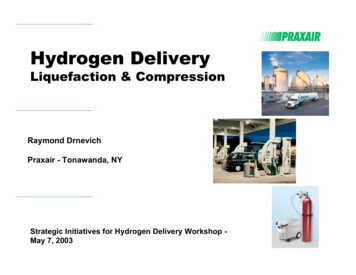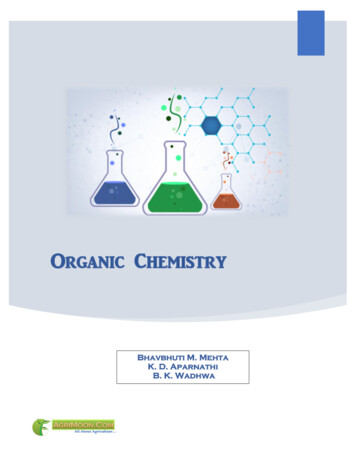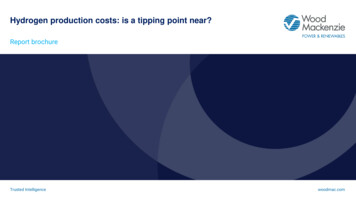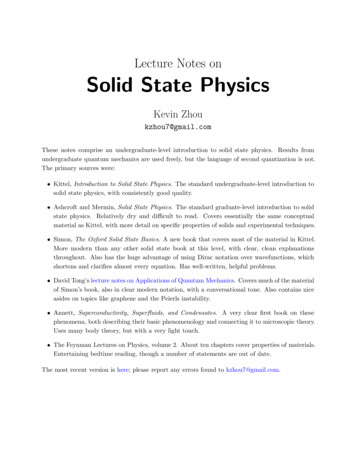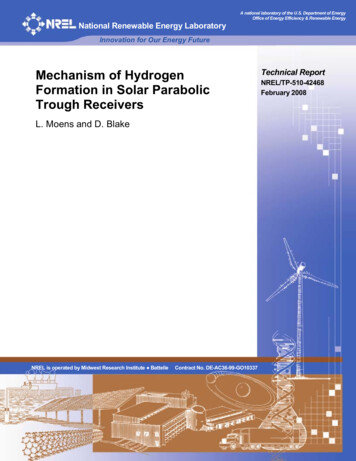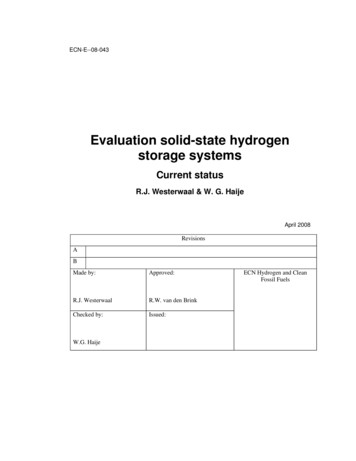
Transcription
ECN-E--08-043Evaluation solid-state hydrogenstorage systemsCurrent statusR.J. Westerwaal & W. G. HaijeApril 2008RevisionsABMade by:Approved:R.J. WesterwaalR.W. van den BrinkChecked by:Issued:W.G. HaijeECN Hydrogen and CleanFossil Fuels
AcknowledgementThe research presented in this report is performed within the ECN “knowledge” projectHydrogen Storage, project number 7.0310 within the unit Hydrogen and Clean Fossil Fuels.AbstractUpon going from a fossil fuel oriented to a hydrogen based economy, a new infrastructure andappropriate technologies have to be developed. An important target is the realization of suitablehydrogen storage systems. There are several methods to store hydrogen, all with their own advantages and limitations. The key issues for successful hydrogen storage are: the reversibility ofhydrogen storage, high storage capacity under real-life conditions, appropriate kinetic and thermodynamic properties, safety and system costs. There are several techniques to store hydrogen,for example as a gas, a liquid, a chemical carrier, physisorbed on large surface structures or aschemically bound in e.g., metal hydrides. In this report to IEA annex XX task B, the currentstatus of hydrogen storage in solid-state materials is evaluated.In this rapport the main focus is on metals and metallic alloys based hydrogen storage materials.Up till now, Mg (doped, catalyzed, and alloyed) has been examined intensively as storage material. However, due to slow kinetics and high desorption temperature, the potential of Mg for onboard applications is limited. Recently, the attention has shifted towards light metals like Li, Be,Na, Mg, B and Al and their complexes and alloys. Although for some compounds the hydrogenstorage capacity is promising, additional research has to be performed to improve the kineticsand thermodynamic properties.A brief inventory of the current activities in the field of materials research and systemdevelopment in the Netherlands and abroad is given.The intrinsic properties of the most important compounds are shortly described in increasingorder of being promising for on-board storage. In order of appearance we treat chemicalhydrides, conventional intermetallic hydrides, Mg-based hydrides and complex light weightmetal hydrides. Also some techniques to improve the hydrogenation behaviour are discussed.Special attention is paid to compounds that can store relatively large gravimetric amounts ofhydrogen such as alanates and borides. Furthermore, the Li-N based ceramic systems forhydrogen storage are considered.The main conclusion is that none of the hydrogen storage materials known today simultaneouslyfulfils all of the targets set by FreeDOM/CAR and the IEA. Some of these are of technicalorigin others deal with public acceptance but despite this there are already many niche marketswith a different set of targets that can already be met. Hands-on experience in these marketswould greatly enhance the practical knowledge on running hydrogen fuelled PEMFC poweredvehicles.2ECN-E --08-043
ContentsList of tables4Summary51.Introduction1.1Hydrogen storage1.2High pressure hydrogen storage1.2.1 Summary high pressure hydrogen storage:1.3Cryogenic liquid hydrogen storage1.3.1 Summary cryogenic hydrogen storage:1.4Other solid-state hydrogen storage mediums and techniques1.4.1 Metallic glasses1.4.2 Gas hydrates/clathrate hydrate1.4.3 Organic liquids779101011111212132.Hydrolytic, pyrolysis, intermetallic hydrogen storage compounds and intrinsicproperties2.1Enthalpy of formation, targets for hydride formation2.2Cycle stability2.3“Classical” hydrogen storage metal hydrides: Hydrolytic2.4“Classical” hydrogen storage metal hydrides: Pyrolysis2.5“Classical” hydrogen storage metal hydrides: Intermetallic compounds2.5.1 Summary intermetallic storage compounds:141416161717183.Mg based hydrides3.1.1 Summary Mg-based storage compounds:19214.New light-weight hydrogen storage compounds4.1Complex hydrides4.1.1 Introduction4.1.2 Mg2XHy4.2Alanates4.2.1 NaAlH44.2.2 LiAlH4 and KAlH44.2.3 Summary alanates storage compounds:4.3Lithium nitrides4.3.1 Summary lithium amide – lithium imide storage 3242424265.Conclusions metal-hydride storage systems5.1Conclusions from review papers5.2General conclusions of the authors2727296.Recommendations6.1Combinatorial research and high throughput screening6.2Goals for on-board hydrogen storage333334Appendix A44Appendix BMetal hydrides and their properties45Appendix CC.1Research on hydrogen storage in the NetherlandsACTS-NWO Sustainable Hydrogen Programme (First Tender)C.1.1 Atomistic modelling of lightweight metal-hydridesC.1.2 Metal-hydride thin films as a tool to find new/improved lightweight storage materialsC.1.3 Optical fibre hydrogen sensors555555ECN-E--08-04355563
C.1.4 Novel nanostructured light metal hydrides for hydrogenstorage-fundamentals and applicationC.1.5 Mechanisms of hydrogen storage in alanates a first principlesapproachC.1.6 High energy density, fluorite-based, hydrogen storagematerialsC.1.7 University of Twente, The NeterlandsACTS-NWO Sustainable Hydrogen Programme (Third Tender)C.2.1 Destabilized, multi-component, Mg-based hydrogen storagematerialsC.2.2 Search for new light-weight hydrogen storage materials usingHydrogenographyC.2.3 In situ NMR analysis of hydrogen storage materialsC.2.4 Hydrogen surface adsorption in porous crystalline materialsC.2.5 Nanostructured hydrogen storage materials: the benefits ofparticle size effects and support interactionC.2.6 Atomistic modelling of advanced hydrogen storage materialsC.2.7 Realisation and application of in-situ TEM of hydrogen storagematerials at 1-10 bar hydrogen pressure and 200 CC.2.8 Promoted hydrogen storage in nanoporous clathrate hydratematerials with enhanced storage capacityC.2.9 Hydrogen sensors and safety detectors for the ndix DD.1D.2D.3D.4D.5Hydrogen storage and future applications programs in EuropeSTORHY: Hydrogen Storage systems for Automotive ApplicationCOSY: research network develops novel hydrogen storage materialsFuncHy - Functional Materials for Mobile Hydrogen StorageNESSHYCurrent running European projects636363636566Appendix EResearch Institutes working on metal hydrides Europe- Japan67Appendix FResearch Institutes working on metal hydrides USAF.1.1 Center of Excellence carbon nanotubesF.1.2 Hydrogen Storage, Engineering Center of Excellence707475List of tablesTable 5.14Selected H2 – storage system and media targets for fuel cell vehicles 27ECN-E --08-043
SummaryIn this report to IEA annex XX task B, an overview is given of the current status of hydrogenstorage materials in connection with on-board hydrogen storage applications. The storage methods and materials discussed here are: High pressure H2 gasCryogenic H2 liquidMetal glassesIntermetallic compoundsMg based hydridesComplex hydrides,Lithium nitridesBorohydridesFor each type of compound the specific hydrogen storage properties and limitations are discussed. The physisorption of hydrogen on large surface area structures (for example carbonbased) is not evaluated here due to the required cryogenic conditions. Furthermore, techniquesto improve hydrogenation kinetics, thermodynamics and storage capacity are presented (ballmilling, addition of catalysts, destabilizing the hydride phase etc).For on-board hydrogen storage international organisations posed some criteria for efficient onboard hydrogen storage. The most important criteria posed by the FreedomCAR/DOE for mobile applications to be met in 2010 are; Useable energy density 1.5 kWh/L, storage weight percent 6 wt.% of H2, operating temperature -30/50 C, cycle life ( 1000 cycles), delivery pressure2.5 bar, refuelling time 3 min (5 kg H2).From a storage point of view, classical intermetallic compounds have a too low gravimetric hydrogen storage capacity for on-board applications. Mg is more promising as storage material,however slow kinetics and unpractical thermodynamics limits its practical use for on-boardstorage. During the last years the attention has shifted towards light weight metals like Li, Be,Na, Mg, B and Al and their compounds. Although the amounts of stored hydrogen are promising for certain compounds, additional research has to be done to improve kinetics, thermodynamics (ad/desorption temperature) and reversibility of the hydrogenation of these compounds.Other promising systems are the Li-N based ceramic systems and combinations of differenttypes of hydrides to modify the overall hydrogenation enthalpies. Considering all these metalsand their alloys, it is concluded that none of the today known compounds will satisfy all the targets simultaneously.Investigation of the current status of storage materials reveal that there are some very importantproperties which are more or less disregarded in research. Although it is generally accepted thatcatalysis plays a vital role in the feasibility of hydrogen storage in metallic compounds, theirworking mechanism is often unknown.Furthermore, most of the experiments on hydrogen storage compounds are performed underideal laboratory conditions. This implies small scale experiments under idealized conditions(high purity hydrogen gas, clean conditions). Therefore it is necessary to investigate the mechanical stability, chemical stability, thermal conductivity and cycle life, because a possible application will operate under non-ideal conditions. Also the tolerance to impurities and contaminations, the adsorption/desorption kinetics under realistic conditions and heat and mass transfersin the material are properties that need to be considered. In this context it is important to realizethat in many reports only the maximal storage capacity is reported and not the effective reversible hydrogen storage capacity, which is in general much lower.ECN-E--08-0435
Also an inventory is given of the current activities and projects on material research andhydrogen storage in the Netherlands and abroad as well.6ECN-E --08-043
1.IntroductionThe inventory of state-of-the-art technologies and new developments in on board hydrogen storage is performed by ECN and made available to IEA Annex XX task B, see Appendix A.1.1Hydrogen storageFor the transition from a fossil fuel to a hydrogen based economy, hydrogen storage is a key issue. One needs to pack the hydrogen as close as possible since the volumetric density at standard conditions is very low. To achieve this goal additional materials and energy are required,since hydrogen is merely an energy carrier. Hydrogen can be stored as a gas, a cryogenic liquid,physisorbed on large specific surface area structures, in metal hydrides, in complex hydrides,and chemical hydrides (by means of chemical reactions). The need to pressurize the gas (highpressures, safety issue, and energy losses) and cooling to liquefy (energy losses) makes the storage in metal-hydrides a very interesting option. Many metals (and alloys) are abundant, cheap,metal hydrides are relatively safe and can contain a high volume density of hydrogen, see Figure1.1. The given values are based on a driving range of 500 km which requires around 4 kg of hydrogen. In this rapport an overview is given of the state-of-the art hydrogen storage materials.Furthermore, some techniques to improve hydrogen storage and system developments are described.The research on new hydrogen storage materials during the last years has shifted towards lightmetals like Li, Be, Na, Mg, B and Al. These metals are particularly interesting due to the factthat they can contain a high weight percentage of hydrogen. The US Department of Energy(DOE) presented several requirements for an on-board hydrogen storage system. Furthermore,to obtain an easy and safe operating system, a low re-hydrogenation pressure is desired. The requirements for effective on-board hydrogen storage are (FreedomCAR/DOE, Japan and IEAtargets are comparable):1)2)3)4)5)6)7)8)9)Appropriate thermodynamics (favourable enthalpies of hydrogen absorption anddesorption),Fast kinetics (quick uptake and release),High storage capacity (specific capacity to be determined by usage),Effective heat transfer,High gravimetric and volumetric densitiesLong cycle lifetime for hydrogen absorption/desorption,High mechanical strength and durability,Safety under normal use and acceptable risk under abnormal conditions,Cheap components and materialsThe specific targets for mobile applications specified by the Department of Energy’s Office ofEnergy Efficiency and Renewable Energy are given in Table A.1 and Table A.2.From literature it is clear that to meet the requirements for hydrogen storage, the current statusof the technology is insufficient. The posed goals cannot be met simultaneously and realizationof these targets requires new breakthroughs in several research fields. For example to give anidea about the system requirements, to drive with an average car 100 km one needs 3 litre ofgasoline (2.21 kg) (energy density gasoline 12.7 kWh/kg) for an average car. This is equivalentwith 0.84 kg of hydrogen (energy density 33.3 kWh/kg). To drive 500 km, 4.2 kg of hydrogen isrequired. To store this amount of hydrogen in for example LaNi5 (weight percentage of 1.4wt.%), one needs 300 kg of metal-hydride material. Besides the weight problem also the heatdevelopment during hydrogenation is important. For an enthalpy of formation of H -35ECN-E--08-0437
kJ/mol H2, the heat release during a 3 minute refilling time is 405 kW, see Figure 1.1(Schlapbach, Züttel, 2001).Mg2NiH4LaNi5H6H2 (liquid)H2 (200 bar)Figure 1.1 Comparison the different hydrogen storage techniques. For on-board hydrogenstorage a metal hydride is preferred due to the large volumetric density. However atthis moment the weight penalty limits its practical application (Schlapbach, Züttel,2001).In addition to the posed targets one can think of (metal) hydrogen storage systems which aresuited for specific purposes. For example if the storage capacity is high enough, one may acceptlower hydrogenation kinetics and not use the full storage capacity of the metal hydride. For onboard applications one can think of only using hydrogen based cars in certain regions, smaller(lighter) cars and metal hydrides for applications in which weight is not really a limitation.Besides the intrinsic hydrogen storage properties of the metal-hydride system like thermodynamics, kinetics, etc, the mechanical and chemical properties of the storage system are equallyimportant for an application. These include expansion and shrinking upon hydrogenation, embrittlement and sensitivity to temperature changes. Upon hydrogen absorption the metallic hostobtains a reduced ductility and tensile strength and repeated hydrogen absorption and desorptioncan pulverize the material. A phase transition during hydrogenation can also be an undesired effect. This can be a metal-hydride phase transition in the same material (for example Mg-MgH2)or a phase transition in a multi component system. Mass transfer and multiple reactions duringthe phase transition usually limit the kinetics and reversibility of the system and sensitivity towater, oxygen, CO etc. is also an issue.Although metal hydrides are considered as ideal hydrogen storage system (mainly due to thehigh volumetric density), an obvious candidate for on-board (automotive) applications is not yetreported. To illustrate this, an extended database of metal hydrides is provided byhttp://hydpark.ca.sandia.gov. This database lists more than 2000 hydride forming elements,compounds and alloys, but does not report one single compound which meets all the posed tar-8ECN-E --08-043
gets simultaneously. Furthermore, it is reported by Grochala et al. (Grochala, Edwards, 2004)that a major dilemma exits for all today known hydrides: or the desorption temperature is lowbut the storage is irreversible or the hydrogen can be stored reversibly but the desorption temperature is too high for practical use. Furthermore, it is well worth to mention that these authorsdo not believe the storage problem will be solved with a binary or ternary metal-hydride compound.In addition it is also important to consider that one has to make the distinction between the theoretical hydrogen storage capacity, hydrogen storage capacity under laboratory conditions, andhydrogen storage under “real-life” conditions. Often only the theoretical storage capacity is reported which can differ largely from the storage capacity under moderate and practical conditions. For intermetallic compounds only 50-90% of the maximum hydrogen storage capacitycan be used and often this does not even include the complete storage system. Furthermore, theinfluence of activation, sensitivity to gas impurities, heat transfer, cyclic stability, protection ofthe metal hydride, and volumetric change on the hydrogen storage capacity is often neglected.According to the U.S Department of Energy some important questions that need to be considered for practical applications are:1)2)3)4)5)6)7)8)9)10)Does hydrogen physisorb or chemisorb?Does it bind molecularly or dissociatively?Where does the hydrogen reside?What is the nature of its hydrogen diffusion mechanism?What are the activation barriers for hydrogen desorption?What adverse effect does hydrogen have on the structural and mechanical stabilityof the host material?What is the nature of bonding of hydrogen with host atoms — ionic, covalent, ormetallic?What roles do surface morphology and defects play in hydrogen absorption and desorption?In what ways is it beneficial to store hydrogen in novel materials, such as nanostructures and porous materials?How do catalysts help in reducing the operating temperature and pressure for hydrogen uptake and release?The posed targets for hydrogen storage are mainly based on the current status of the automotiveindustry. With this in mind, we are mainly interested in materials and techniques for on-boardhydrogen storage since the storage properties for stationary applications greatly differ. To becomplete we consider here the three most mature forms of hydrogen storage today: gas, liquid,and solid (sorption) materials, with the main focus on storage techniques and materials.1.2High pressure hydrogen storageFor gaseous hydrogen storage under high pressure there are some techniques like steel tanks,composite tanks, glass spheres etc. The most mature and promising technique are the carbonfibre-wrapped hydrogen composite storage tanks. These tanks are available, safety-tested, simple of construction and can contain pressures up to 700 bar (6.7 wt.%). There are already severalpilot applications in the world today using this technique, but high pressure storage has somedisadvantages. The large physical volume required (does not meet the volumetric target), highcosts and safety issues are still under investigation and discussion. Furthermore, as the storagecapacity of a composite tank is limited by the molecular interaction of the hydrogen, an increasein pressure is not proportional to an increase in storage capacity at higher pressure, see Figure1.2. Another restriction is the considerable energy loss during pressurization of the hydrogenECN-E--08-0439
gas which is typically in the order of 12 – 16 % for compression to 800 bar (depending on thetype of compression). Further research is required to obtain commercial applications.Figure 1.2 Volumetric density of compressed hydrogen gas as a function of gas pressureincluding the ideal gas and liquid hydrogen storage. The ratio of the wall thicknessto the outer diameter of the pressure cylinder is shown on the right hand side forsteel with a tensile strength of 460 MPa. A schematic drawing of the pressurecylinder is shown in the inset. The deviations from the ideal gas line are indirect aconsequence of the change in chemical potential as function of pressure andtemperature (Züttel, 2003a).1.2.1 Summary high pressure hydrogen storage: 1.3Most mature method for the momentRequires further R&D on materials and techniquesMany applications already realized (6.7 wt% 700 bar)Does not meet the vol.% targetEnergy loss (12-16% at 800 bar)Requires safety consideration and public acceptationCryogenic liquid hydrogen storageHydrogen can also be stored in the form of a cryogenic liquid (-253 C) or stored as a constituentin other liquids such as NaBH4 solutions, rechargeable organic liquids, or anhydrous ammoniaNH3. Liquid hydrogen is already used in some commercial vehicles. Liquid hydrogen has a density of 70.8 kg/m3 and a gravimetric density of 100% like gaseous hydrogen. However, in practical applications only 20 wt.% of hydrogen can be achieved today. The main advantage of liquid hydrogen is its high storage density at relative low pressures. Liquid hydrogen has a muchbetter energy density then pressurized hydrogen but a large amount of energy is required for theliquefying process. The energy required for the liquefying process is Wprac 10 kWh/kg whilethe higher heating value (HHV) of hydrogen 39.4 kWh/kg. This means that at least 25% of theenergy is lost (30-40% is more realistic). To retain cryogenic conditions, super insulated tanks10ECN-E --08-043
should be used however the boil-off loss during dormancy is also a severe limitation. In order tolimit these losses, the storage system becomes relatively complicated, see Figure 1.3.Figure 1.3 Example of a cryogenic hydrogen storage system. (Source: www.Linde.com).1.3.1 Summary cryogenic hydrogen storage: High vol.% capacity (70.8 kg/m3) High wt.% capacity (practical 20 wt.) From ortho-hydrogen to para-hydrogen upon liquefaction, heat is released(phase transition) A minimum of 25% energy loss due to liquefaction Loss of efficiency due to evaporation (boil-off) Complicated system requirements1.4Other solid-state hydrogen storage mediums and techniquesBesides high pressure hydrogen storage, cryogenic liquid hydrogen storage and storage in metalbased compounds, there are other hydrogen storage techniques. The ones based on the physisorption of hydrogen at relatively low temperatures on large surface structures or the encapsulation and physical trapping of hydrogen are: Carbon based structures, hydrogenated amorphouscarbon, self-assembled nano composites/aerogels (foams), Zeolites (crystalline nano porous materials, Metal Organic Frameworks (MOF of which an example is shown in Figure 1.4), encapsulated in glass microspheres, boron nitride nanotubes, and hydrogen in hydrates and clathrates.When physisorption is involved, cryogenic processes are necessary with similar drawbacks asfor liquid hydrogen storage.ECN-E--08-04311
Figure 1.4 The minimised unit cell of MOF5 viewed from two different direction directions. Leftthe open pore structure is visible. White spheres: hydrogen, light gray: carbon, darkgrey: oxygen, black: zinc. The hydrogen adsorption sites are indicated by arrows(Mulder, 2005).Some based on chemical storage are: bulk crystalline/amorphous materials (multi-componentalloys), chemical storage media or hydrogen carriers (methanol, ammonia, etc) and reversiblehydrogenation of organic liquids (CxHy) where the efficiency of the last two depend on the conversion and selectivity of the reactions involved. Here three methods are discussed more extensively, namely the metallic glasses, gas hydrates/clathrate hydrates and the organic liquids.1.4.1 Metallic glassesMost metals and alloys of different types of metals adopt some crystalline structure. Metalswithout any form of crystalline structure are amorphous and referred to as metallic glasses orglassy metals. The hydrogen storage capacity of these materials depends strongly on the microstructure of the compound as the hydrogen is trapped at interstitial sites. Kumar et al. (Kumar,Wang, 2004) reported that Zr and Cu based metallic glasses can absorb an appreciable amountof hydrogen but the storage is irreversible. The hydrogen induced a crystallization process uponheating. Metal glasses based on Fe and Y are inert to hydrogen. The hydrogen absorption by themetal glass Zr50Ti5Al10Cu22Ni13 is investigated by Soubeyroux et al. (Soubeyroux, 2003). Theyfound that the formed hydride depends strongly on the specific structure of the metal glass.ZrH2 is formed when hydrogen is applied to the amorphous phase and Zr2NiH4 is formed in caseof the intermetallic phase. A Pd coated metal glass shows improved desorption kinetics and fulldesorption is obtained even below 300 C for hydrogen concentrations up to H/M 0.4. However, higher hydrogen concentrations lead to irreversible changes in composition (Zander,2003).From the limited amount of publications on these compounds it is obvious that the hydrogenation process and the subsequent heating to release the hydrogen have a large impact on microstructure and crystalline structure of the metal glass. It is therefore questionable if these systemsare stable under repeated cycling. Furthermore, the compounds considered so far contain Zr, Cu,and Ni, which are relative heavy elements which result in a low gravimetric hydrogen storagecapacity. The research on these types of materials is still in an early stage and the focus is onlight metal glasses.1.4.2 Gas hydrates/clathrate hydrateClathrate hydrates can also be used to store hydrogen. A clathrate consist of a hydrogen-bondedwater host lattice that can contain one or more types of so-called guest molecules. Current research is performed to identify mechanisms that decrease the stability of the clathrate hydridesand determine the thermodynamically most favoured cage occupancy (Sluiter, 2004).It is known that hydrogen clusters can be stabilized in a clathrate hydrate at very high pressuresof 220 MPa at 249K. (Mao, 2002) (Mao, Mao, 2004). Florusse et al. showed that hydrogen clus-12ECN-E --08-043
ters can be stabilized and stored at low pressures within the sII clathrate hydrate lattice by stabilizing the large water cages with the compound tetra-hydrofuran (THF). Tetra-hydrofuran isable to stabilize the clathrate at a pressure of 5 MPa at 279.6 K versus 300 MPa at 280K for apure H2 hydrate. It is shown that promoter guest molecules can be used to store hydrogen in abinary clathrate hydrate at low pressures. By the optimization of this promoter, the storage ofhydrogen might be increased. However the use of these clathrates as hydrogen storage is a quitenew research field. In case of sII binary hydrogen hydrate, with double occupancy of the smallcavities by H2 and the large cavities partially occupied by THF, the mass of hydrogen could beup to 4%. This is however far from the desired storage capacities required for on-board applications. Further research on this system has to be done to determine its full potential and limitations. It is obvious that temperature excursions of this type of storage system should be prevented.1.4.3 Organic liquidsHydrogen can also be stored in the form of hydrogen carriers, for example organic liquids. Thereversible catalytic dehydrogenation of methylcyclohexane (C7H14) to toluene (C7H8) occurs according to the following reaction, see Figure 1.5:C7H14(l) C7H8(l) 3H2 (g) (Tdes 300-400 C)which involves 6.1 wt.% of hydrogen. The main disadvantages of organic liquids when used forhydrogen storage are the rest product after dehydrogenation which needs to be sent back to arecycle plant for rehydrogenation. Both rehydrogenation and hydrogenation are catalyzed processes with selectivity and conversion well below 100%. This means that by-products have to beremoved which makes the process energy intensive, expensive, and dirty. The very limited cyclelife is a restriction of this system. Furthermore, the methylcyclohexane is a liquid which can react strongly with oxidants resulting in explosion and fire. Therefore the use of these types ofstorage systems for on-board storage is questionable.Figure 1.5 Hydrogen storage in the form of organic liquids. Upon going from Decalin(Tetralin) to Naphthalene and from Methylcyclohexane to Toluene results in therelease of hydrogen. This process can be used as hydrogen storage or hydrogencarrier material (Source: Y. Saito Organic Hydrides for Carrying Hydrogen,International H2 storage Technologies Conference, Italy 2005).ECN-E--08-04313
2.Hydrolytic, pyrolysis, intermetallic hydrogen storage compounds and intrinsic properties2.1Enthalpy of formation, targets for hydride formationFor a system in thermodynamic equilibrium, the equilibrium pressure p0 of the monovariant heterogeneous equilibrium reaction (Bevers, 2006; Bevers, 2007),A(s) xB(g) C(s)Figure 2.1 For a typical intermetallic compound the pressure composition isotherms are shownon the left of the figure. From left to right are shown the α - phase, the coexistenceof the α and β phase and the β - phase region. The coexistence of the two phases ischaracterized by the nearly flat plateau’s which for increasing temperature ends upin the critical temperature. The slope of the Van ’t Hoff plot is equal to the enthalpyof formation divided by the gas constant and its intercept is the entropy of formationdivided by the gas constant (Züttel, 2003a)is given by r G (T ) r G 0 (T ) xRT lnp(T ) 0p0The molar Gibbs energy change of the reaction is given by G, p0 is a reference pressure, G0 isthe Gibbs energy change at p0, and R the gas constant. In combination with r G 0 r H 0 T r S 0where the enthalpy (kJ mol-1 H2) and entropy (JK-1 mol-1 H2 at 105 Pa) are given by H and S respectively, for the equilibrium pressure p(T) we find thatln H 0 1 r S 0 (T )p (T ) rp0xR xR T The loss of entropy when the hydrogen gas is absorbed by the solid determines the entropychange rS0 -SH2 -130.684 J K-1 mol-1 H2 at a pressure of 105 Pa and room temperature (30014ECN-E --08-043
K). By plotting the logarithm of pressure versus the reciprocal temperature, see F
ideal laboratory conditions. This implies small scale experiments under idealized conditions (high purity hydrogen gas, clean conditions). Therefore it is necessary to investigate the me-chanical stability, chemical stability, thermal conductivity and cycle life, because a possible ap-plication will operate under non-ideal conditions.
